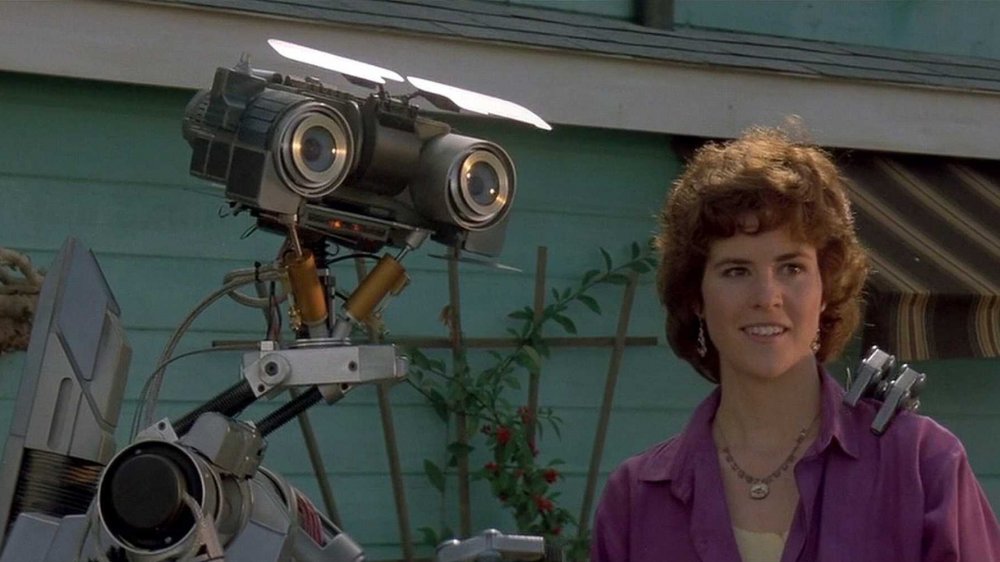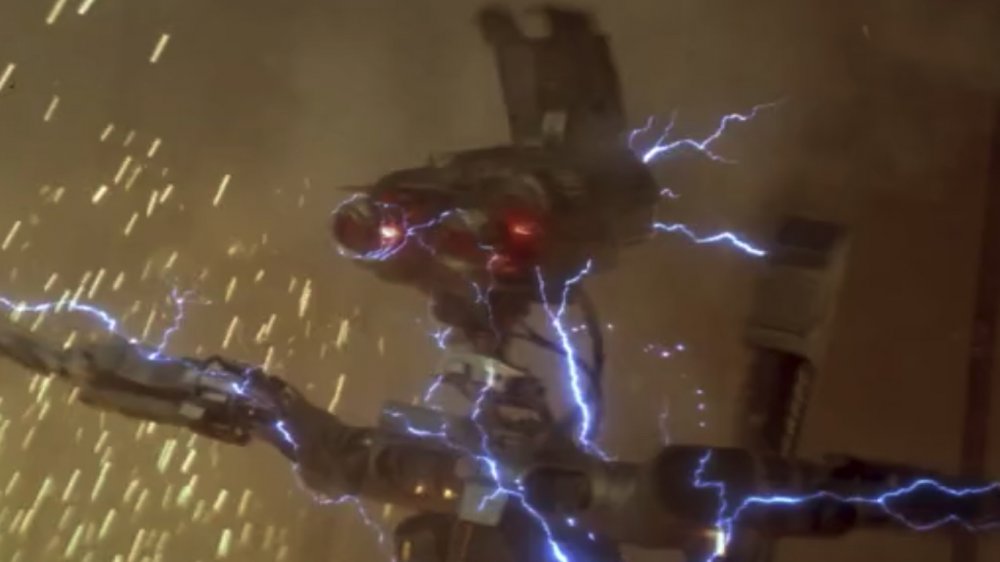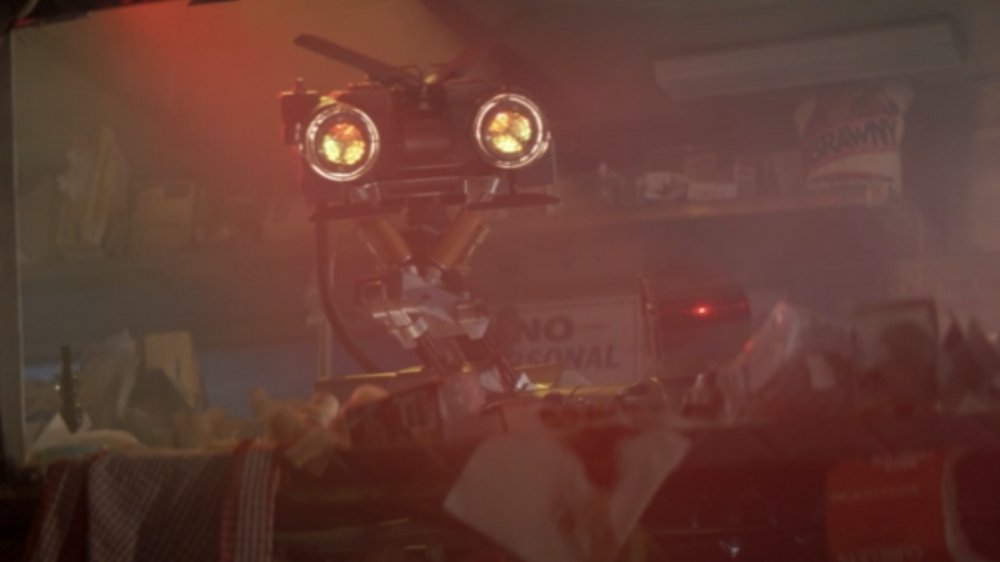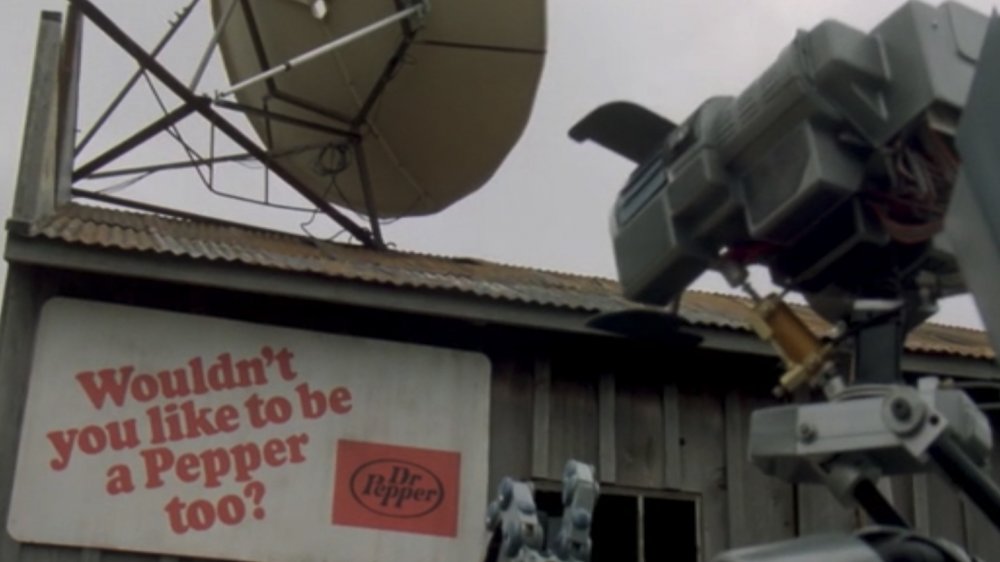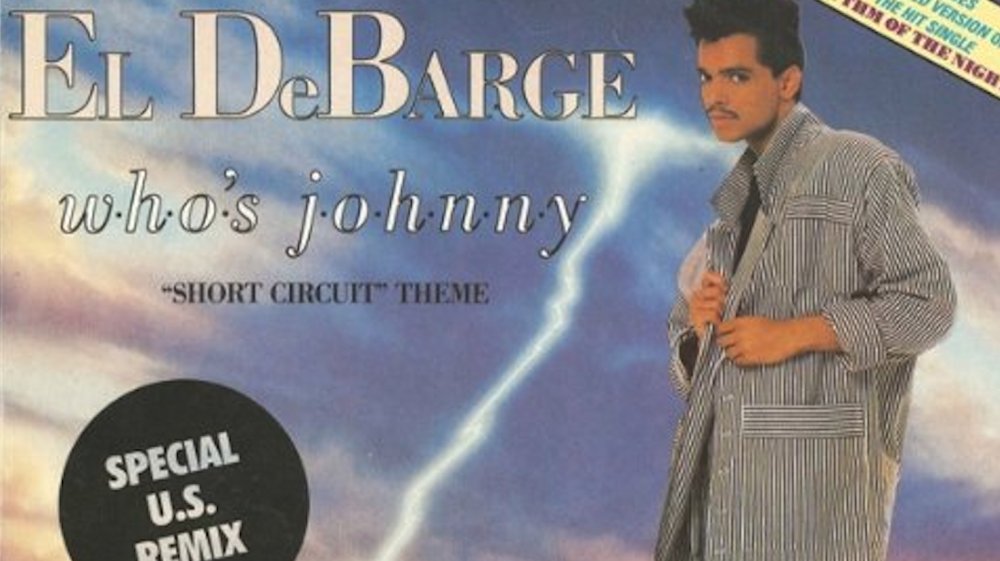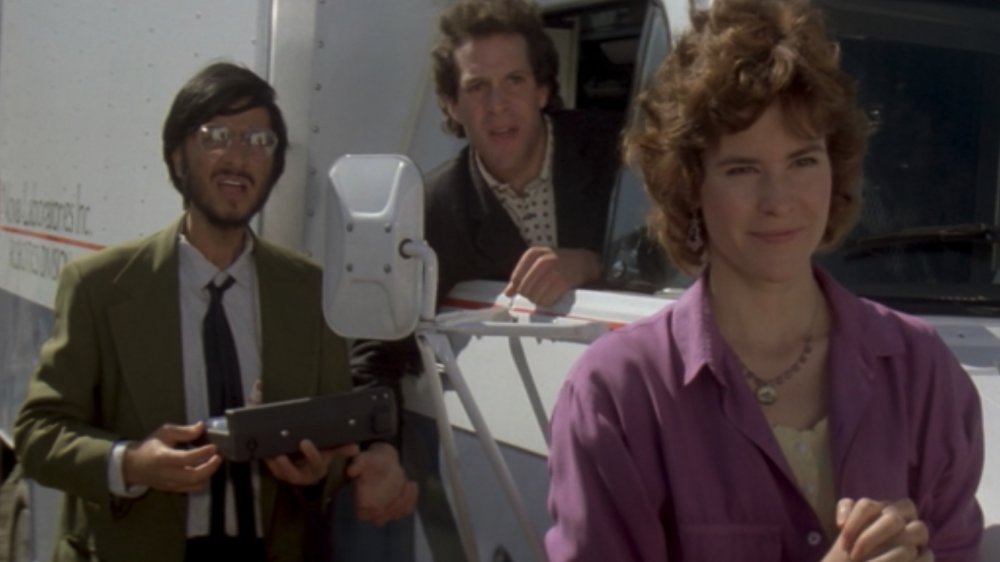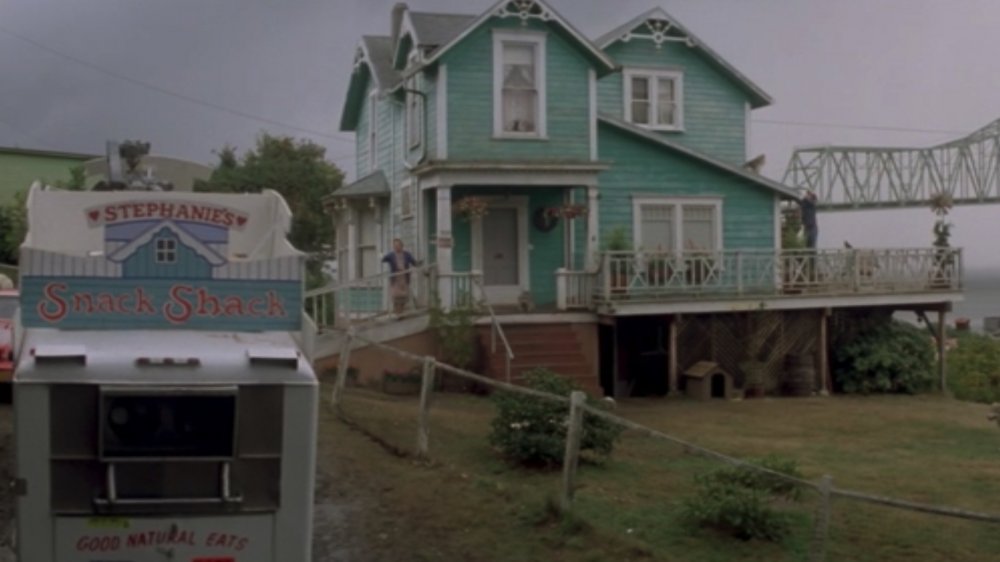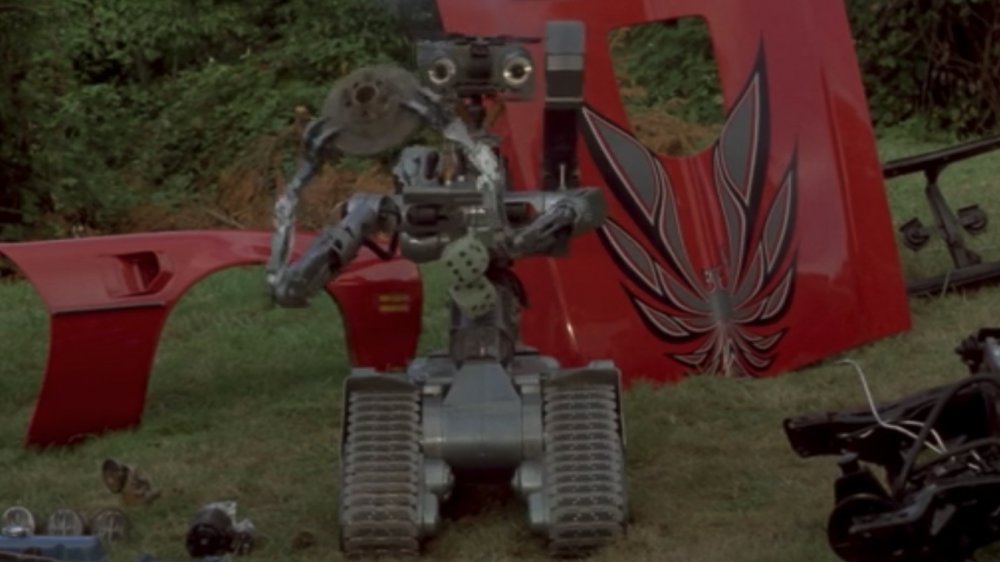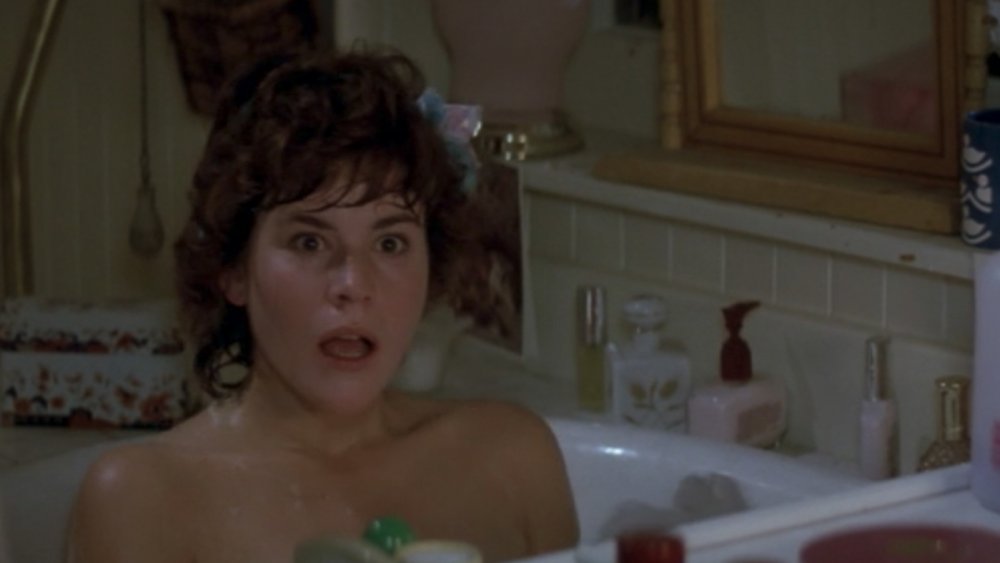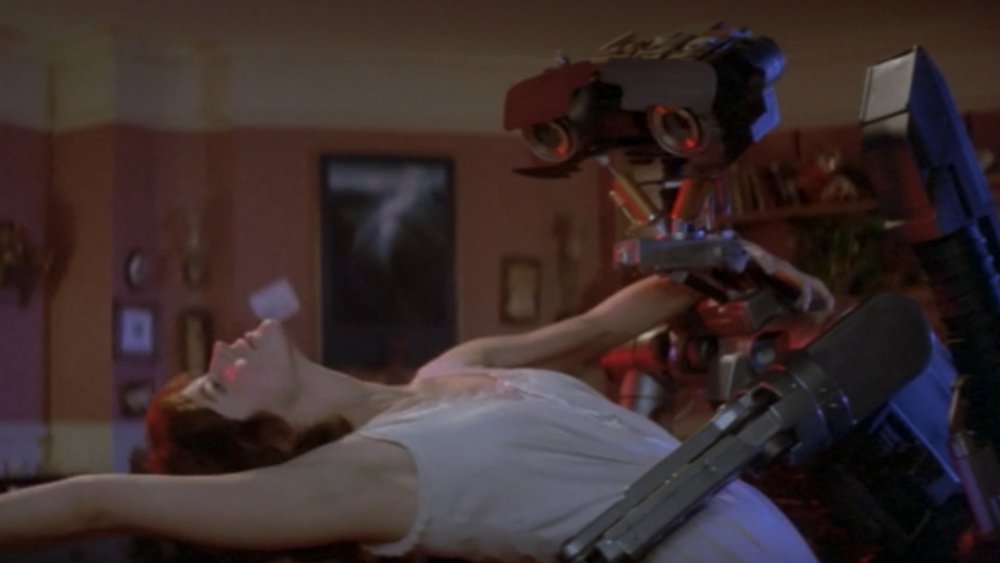Things Only Adults Notice In Short Circuit
1980s kids movies were obsessed with cute robots and aliens with big hearts. The massive success of E.T. and Return of the Jedi, with its oodles of cuddly Ewoks, spawned an era of sci-fi kiddie movies — and Short Circuit, with its friendly robot Number 5, was one of the many films that followed the formula. Introduce an alien intelligence. Have it befriend savvy, independent-minded young people. Instruct it in the ways of American pop culture. Throw in some narrow-minded baddies that want to capture, kill, reprogram, or otherwise extinguish the entity's delicate spirit. Let chases and emotional bonding ensue.
Though not a gargantuan success on par with E.T., Short Circuit was a hit, spawning a sequel several years later. While the movie has not become as cherished over the years as other family-friendly sci-fi/fantasy from the same era, such as Goonies or Back to the Future, it nevertheless has hung around the edges of pop culture. For example, some believe that the design of the robot in Pixar's Wall-E owes a lot to Number 5.
Decades after the movie first hit theaters, Short Circuit still basically plays like an extended cartoon with silly hijinks and harmless violence (Number 5 even quotes Bugs Bunny). But there are a number of moments — some amusing, some eye-raising, some downright offensive — that only adults are likely to notice.
Lightning strikes are magical in movies like this, never deadly
Number 5 is just another Nova Laboratories military robot until he "comes alive," so to speak, after he is struck by lightning outside the labs. The idea that lightning is possessed of magical transformative powers is a staple of fiction. The most famous movie precedent for Number 5's electrical awakening is Frankenstein. But magical powers, extended life, second sight, and altered consciousness are bestowed by lighting in movies and TV shows as varied as Powder, The Age of Adaline, and The Misfits. Many superheroes, wizards, and Star Wars Force wielders can manipulate and control lightning. A lightning bolt even sends Marty McFly through time in Back to the Future.
Without suffering any damage (and without any explanation for how it could be possible,) Number 5 develops sentience instantaneously as a result of the strike, along with free will and a desire to learn and grow. Adults, of course, realize that lightning is dangerous and destructive, causing massive wildfires, power outages, and striking people dead. But for kids watching this movie, "sparkly miracle from the sky" is explanation enough to transform a rolling scrap heap into a cuddly family member.
Stephanie insists on befriending Number 5 even before she knows if he is safe
After Number 5 escapes Nova, he ends up at the home of Stephanie Speck (Ally Sheedy), and hides out in her van. When Stephanie goes to investigate, she is initially cautious, carrying a baseball bat and threatening to call the cops. With canted angles, creepy music, eerie lights, fog, and hooting owls, the film clearly establishes the situation as menacing. And yet as soon as Number 5 reveals himself, Stephanie's eyes light up and she sheds all caution. Even though Number 5, bathed in a red glow, seems utterly sinister, she immediately assumes he is a friendly alien. "I knew they'd pick me!" she exclaims, then aggressively tries to befriend him.
Thank Steven Spielberg for this. His films E.T. and Close Encounters of the Third Kind kicked off the era of friendly alien movies such as Cocoon, Batteries Not Included, Starman, Explorers, and even ALF on TV. With their steady diet of harmless and benign aliens, kids of the era probably didn't even consider that Stephanie might be in danger — especially since the scene rehashes the one in E.T. when Elliot discovers E.T. hiding in the garden shed. Of course if Number 5 had been a threat, he could have easily vaporized Stephanie. Perhaps if Short Circuit had been made in the 1950s, when sci-fi tended to treat aliens as threats to humanity, he would have.
The movie is a particularly shameless example of '80s product placement
In the 1980s, product placement in movies really took off. One of the most famous early examples of the lucrative advertising process was E.T. When Elliot first tries to lure E.T. out of the garden shed, he does so with a trail of Reese's Pieces. Universal Pictures had first offered the tie-in opportunity to M&M's, but Mars, Inc., the parent company, declined. When E.T. became a blockbuster, sales of Reese's Pieces soared.
Other companies weren't keen to make the same mistake and the gold rush was on, with soda brands in particular appearing in movie after movie. But Short Circuit isn't content to simply feature a giant billboard of Dr. Pepper. It shoehorns in dozens of other products as well. Number 5 learns how to behave through watching TV, which gives the movie ample opportunities to broadcast commercials within the plot, and boy does it. Product placements include Alaska Airlines, Polaroid, Brawny, Ore-Ida potatoes, Thomas' English Muffins, Pontiac, Campbell's soup, Duracell, Charmin, and others.
Of course, '80s kids probably wouldn't have noticed. Not only were they used to seeing the same commercials all the time on TV, but kid shows of the era such as G.I. Joe, Care Bears, My Little Pony, Transformers, and He-Man were basically designed as episode-length commercials to sell toys.
Short Circuit is also a prime example of '80s soundtrack mania
Along with product placement, movie tie-in soundtracks went into overdrive in the 1980s. Albums such as Purple Rain, Footloose, Flashdance, Top Gun, Beverly Hills Cop, and Dirty Dancing were not just promotional opportunities for the movies, but often mega-sellers in their own right. Lining up big recording artists like Huey Lewis and Kenny Loggins became standard practice for studio films.
El DeBarge was not a huge act like Lewis or Loggins, but Short Circuit was instrumental in launching his solo career with the breakout hit from the movie, "Who's Johnny," which is prominently featured in two separate scenes. In one scene, the pop tune plays as Stephanie gives Number 5 a tour of her house. Later, Number 5 recognizes it on the radio and practically crashes the van he's driving in his excitement. He is so taken by the catchy confection he even changes his name to "Johnny Five" at the end of the film.
The music video for "Who's Johnny" further took advantage of the synergy between the movie and the song by featuring Number 5 and other characters from Short Circuit. Of course, kids watching the film have no idea of the sophisticated marketing strategies in play. They're just bopping along with Number 5.
Fisher Stevens in brownface is offensive
The makers of Short Circuit had no problem casting Fisher Stevens, a white actor, as the engineer Ben Jabituya, a stereotyped South Asian American of undefined origin. The movie tries to wring laughs at every turn from Ben's broken English and malapropisms, such as "Well the cat has dragged in a sight for four eyes," and "Eat my dust, let us break wind." Ben is portrayed as a neutered nerd with an accent reminiscent of Apu from The Simpsons, another South Asian character played by a white actor (Hank Azaria) that audiences accepted for years, then eventually rejected. This sort of racist depiction is particularly damaging in kids' movies because children don't have the critical faculties to recognize the stereotypes or understand why they are harmful.
White people playing non-white people is a distressingly common feature of American cinema. But if Short Circuit had featured blackface at this level of egregious stereotype, even 1980s audiences likely would have boycotted the movie. Instead, the character of Ben was so popular, Stevens was asked to be the lead in Short Circuit 2 a few years later. The Indian actor and comedian Aziz Ansari has criticized Stevens' casting as Ben on more than one occasion, pointing out that the few roles available for Indians and other South Asians in American movies should not go to white actors.
Unless she inherited it, there's no way Stephanie can afford her Astoria home
Astoria, Oregon, with its lovely homes and gorgeous views, was a popular spot for film production in the '80s and '90s. Movies shot on location there include The Goonies, Kindergarten Cop, Free Willy, Come see the Paradise, and Short Circuit — the latter of which finds Stephanie living in a hillside home with an incredible view of the Columbia River.
Not only does Stephanie appear to live by herself in the spacious three-level abode (no parents, no roommates, no significant other), but she also uses the property to house and feed dozens of foster animals (including possums, ferrets, and who knows what else). She manages to maintain the acreage and care for the critters even though her sole income appears to be from selling snacks from a truck. (This job also allows her to conveniently take time off work whenever the plot needs her to). Another benefit of the sprawling spread, which includes a wraparound deck facing the river, is that it provides ample space for the ungainly Number 5 to dance, cook, and otherwise crash about uninhibited.
Stephanie joins a long list of characters of modest means living in pricey digs they could never afford, including Lois Lane — a reporter — who lived alone in a penthouse apartment in Manhattan (one of Roger Ebert's favorite examples of the trope). Of course this is something most kids, with their limited understanding of adult finances, wouldn't notice.
Number 5's escapades cause millions of dollars of damage
In his attempts to evade the Nova military contractors who want to recapture and potentially disassemble him, Number 5 goes on a rampage of destruction that includes trashing much of the local community. At one point, pinned down by an armed security force, the robot blows up a marina full of boats with his laser. In other scenes, he dismantles Stephanie's ex-boyfriend's car and wrecks a local restaurant.
Inexplicably for a robot with tank treads for feet, Number 5 does a lot of driving in the movie. Needless to say, he's not very good at it, and much of the destruction he wreaks comes from behind the wheel. Barreling down a winding hill in Stephanie's lunch van, he manages to clip just about every parked car or garbage bin in sight. Not content to contain his damage away from home, Number 5 also trashes Stephanie's house, then almost burns it down trying to cook breakfast. He also obliterates her beautiful wraparound veranda, plunging through it into the chicken coop below. (The undamaged veranda is magically rebuilt the next day).
Of course, most kids are hooting at the Bugs Bunny-esque nature of the carnage. It has no real world consequences for them. Meanwhile, adults might be thinking that if their neighborhoods met a similar fate, they'd be coming up the hill to Stephanie's house with torches and pitchforks to melt Number 5 down into lug nuts.
The scientists are bumbling, half-witted, and sexist
Ben and his fellow scientist Newton Crosby (Steve Guttenberg) are presented as naive virgins who are completely unable to function in the real world. For example, when Number 5 escapes Nova and the two commandeer a van to go after him, Newton barely knows how to drive. Never mind that he has advanced degrees and has invented a robotic engineering marvel, he somehow can't manage a stick shift. Does he not drive himself to work?
Worse, the two men regard women as though they are encountering them for the first time on another planet. Ben is beside himself at the opportunity to even interact with a woman. When he meets Stephanie, he asks her, "Oh, you're a girl, right?" But he's just getting warmed up. His other comments include: "You cannot hold your water with that story, girlie." "Her pants are blazing for you." "Bye bye goofy women, I enjoyed repeatedly throwing you to the ground." "Let's go scrape up some female chicks." Seriously, outside of emergencies, do they ever let these guys out of the lab?
Not to be outdone by his creators, Number 5 is also a sexist creep. He barges in on Stephanie while she's in the tub and ogles her body. Later, he won't take no for an answer when he asks her to dance. When she kisses someone, he demands one for himself. Evidently, the processor doesn't fall far from the tree.
Short Circuit's Cold War paranoia
'80s action and war movies were obsessed with battling the Soviets. How could they not be, with the threat of nuclear holocaust hanging over the world and President Regan calling them "the evil empire?" As such, the Soviet military became the convenient villain in movies such as Firefox, Red Dawn, Rocky IV, Rambo III, and many others. This seems natural enough for certain genres, but Hollywood's obsession with the Soviets also made its way into the comedies of the era in movies such as Real Genius, Spies Like Us, Stripes, and Best Defense.
These movies always revolve around some kind of high-tech weapon designed to take down the Soviet military. In Short Circuit, Number 5 and his fellow robots are the high-tech weapons, designed to "carry a 25 megaton nuclear bomb right up the middle of Main Street, Moscow." In the opening scene, Nova puts on a demonstration of the robots' capabilities for the U.S. military. As mock enemy tanks carrying mannequins dressed as Soviet soldiers advance, the robots annihilate them with their lasers. Adults understand the geopolitical references, but little kids especially might be cowering under their seats as these scary robots — their eyes glowing red like the Terminator — leave a battlefield smoking with scorched lifelike mannequins.
Director John Badham pays extended homage to his own movie
Prior to Short Circuit, director John Badham made other action movies featuring military hardware — specifically WarGames and Blue Thunder. But when it comes to paying homage to his own work here, he goes in an entirely different direction and showcases his mega-hit dance drama Saturday Night Fever, starring John Travolta. As Number 5 watches the movie on TV, he twirls around Stephanie's living room, mimicking Travolta's moves, including the famous finger point.
Badham doesn't just give us a passing glimpse of his earlier film, either. After the extended scene of Number 5 dancing, with a generous number of shots from Fever, he gives us a second scene in which Stephanie and Number 5 slow dance together while Travolta and Karen Lynn Gorney (whose character in Fever is also named Stephanie) cut a rug on the small screen behind them.
While kids are tickled by Number 5's disco dancing, adults may be wondering if the extended homage isn't a signal from Badham that the acclaimed Saturday Night Fever is the kind of movie he would rather be making — instead of one in which one robot stuffs another robot into an outhouse.
